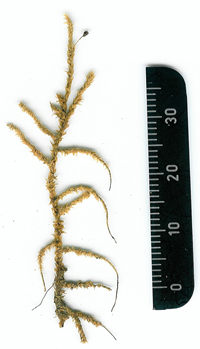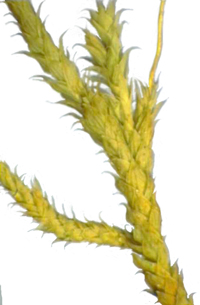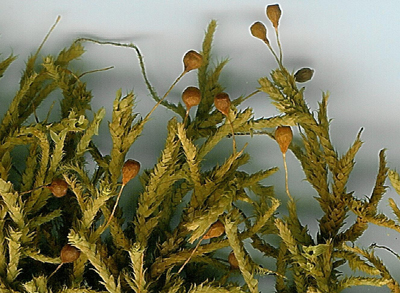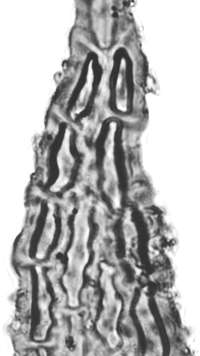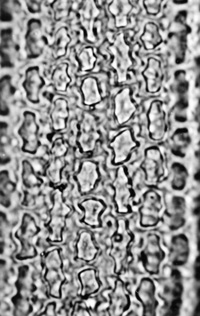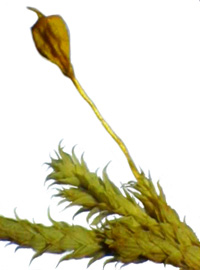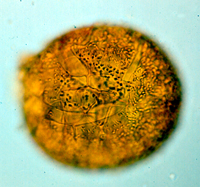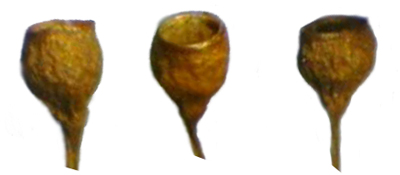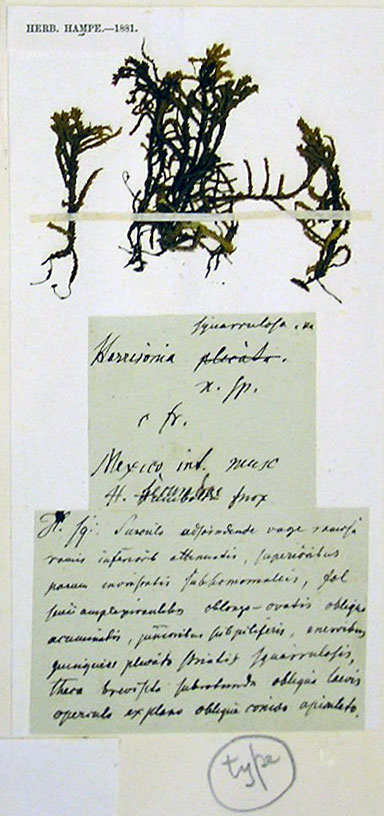
HEDWIGIACEAE
Braunia
Efrain De Luna, web page
Biodiversidad y Sistemática, INECOL. Xalapa. México
|
Hedwigia Pseudobraunia |
|
Braunia squarrulosa (Hampe) Müll. Hal., Linnaea 42: 380. 1879. Harrisonia squarrulosa Hampe, Linnaea 12: 349. 1838; Hedwigidium squarrulosum (Hampe) Bruch & Schimp., Bryol. Eur. 3: 161. 1846; Hedwigia squarrulosa (Hampe) Mitt., J. Linn. Soc. Bot. 12: 407. 1869. Protologue. "Mexico, Inter muscos Mexicanos, terrestris?". Type: Mexico, Schlechtendahl s n. Hampe Hb. (Lectotype designated in De Luna, 2009: bm!; isolectotypes, bm!, ny!). Neckera sphaerocarpa Müll. Hal., Syn. Musc. Frond. 2: 105. 1851; Braunia sphaerocarpa (Müll. Hal.) Müll. Hal., Bull. Herb. Boiss. 5: 201. 1897. Protologue. "Mexico: C. Ehrenberg. E Guatemala copiose communicavit Kegel." Types: Mexico, Mineral del Monte, in arbor. C. Ehrenberg s n. (Lectotype designated in De Luna, 2009: bm!); Guatemala, communicavit H. Kegel (syntypes, bm!, je!, ny!). Neckera liebmanniana Müll. Hal., Syn. Musc. Frond. 2: 668. 1851; Hedwigidium liebmannianum (Müll. Hal.) Schimp., Syn. Musc. Eur. ed. 1, 239. 1860; Hedwigia liebmanniana (Müll. Hal.) Mitt., J. Linn. Soc., Bot. 12: 407. 1869; Braunia liebmanniana (Müll. Hal.) Besch., Mém. Soc. Sci. Nat. Cherbourg 16: 185. 1872; Braunia liebmanii Kindb., Enum. Bryin. Exot. 8, 1888, nom. illeg. Protologue. "Mexico. In monte Orizabensi: Liebmann". Type: Mexico, Orizaba, Liebmann (Lectotype designated in De Luna, 2009: bm!; isolectotypes, bm!, ny!). |
|
Description. Plants robust in dense mats; stems with sympodial branching, plagiotropic, (3–)5–7(–10) cm long, scarcely branched; branches arcuate, flexuose; flagelliform branches frequent; pseudoparaphylia foliose, with papillose cells. Leaves ovate or oblong-lanceolate, widest point below middle of leaf; acumen gradually differentiated, to 1/4 length of leaf, acuminate to cuspidate, sometimes ending in a flexuose point, concolorous, 2.0–2.5 × 0.8–1.3 mm, concave, imbricate, erect-patent when dry, spreading squarrose when moist, strongly plicate; margins reflexed, sometimes recurved in lower 1/2, entire or papillose-crenulate; apical leaf cells 22–31 µm long, elliptic, narrow (4–7:1), sinuose, with few low marginal papillae; upper and median leaf cells 12-20 mm long, elliptic (3–5:1), walls nodulose, sinuose, papillae low, on side walls, overarching lumina. Autoicous. Archegonia distal on short vaginula (1.4–1.6 mm); perichaetial leaves oblong lanceolate, 2.4–2.6 mm long, slightly longer than vegetative leaves, acuminate, plicate; perichaetial paraphyses biseriate at base, 2–3 times longer than archegonia, immersed. Setae (3–(4–5)–8) mm long; capsule exserted, necks 0.3–0.4 mm long, sharply differentiated, broad, urns 1.2–1.6 mm long, urceolate to globose, mouth broad, nearly as wide as urn, capsule walls smooth, or wrinkled when dry, exothecial cells polygonal; stomates superficial; opercula base conical, short oblique rostrate. Calyptrae cucullate, large, hairy. Spores multicellular, 35–42 µm in diameter.
Habitat. This species has been collected epiphytically (base of trees, on oak trunks, on bark of Juniper, on trunk of Cupressus), on fallen tree branches, forming carpets on very decayed logs, and on volcanic rocks (rarely on soil). It is very common in coniferous and broadleaf forests at middle elevations (1500–2900 m). Distribution. Mexico, Guatemala, Costa Rica, Honduras and Panama. Illustrations. Hampe (1844: 19, as Harrisonia squarrulosa); Bartram (1949: 235, fig. 106, A-C); Crum (1994: 666, fig. g-i); De Luna (2009?, Fig. 1-17). Selected specimens examined. Mexico. chiapas: along route 190, Hermann 26429 (br, duke, ny); 9 km südlich San Cristobal, Düll 8 (B). Lake Jusnajay, NW of Comitán, Sharp 3538 (DUKE). 1 km above Aguacatenango, Breedlove 68973 (DUKE). distrito federal: Cima, Pringle 10550 (bm, ny); durango: near Puerto Buenos Aires, Breedlove 69154 (duke); guerrero: about 40 km W of Chilpancingo, Dieterle 3192 (duke); hidalgo: Mineral del Monte, Ehrenberg s.n. (lectotype, bm); Jacala, Frye and Frye 2713 (DUKE, G). jalisco: Sierra Madre W of Bolaños, Rose #e (ny); El Cuartón, above Manantlán, Crum 1175 (DUKE). méxico: Valle de Bravo, Düll 55a (je); Temascaltepec, Dziekanowski, Dunn and Balinbroke 2005 (BM). michoacán: Mil Cumbres, cerca de Puerto Garnica, De Luna 1772 (duke, xal); San Miguel del Monte Morelia, Solorzano s. n. 1908 (JE). Vecinity of Morelia, Cerro Azul, Arsene 4539 (BM). West of Cd. Hidalgo, Delgadillo 457 (MEXU). morelos: Tres Cumbres, Zempoala, Düll 152 (je); oaxaca: Sierra de Juárez, Düll 66 (je); El Punto, NE of Oaxaca, Conrad and Conrad 3160 (DUKE). 23 kms NE of Oaxaca, Delgadillo 628 (MEXU, XAL). sinaloa: about 6 mi W of Las Palmitas, Norris et al 20444 (br); veracruz: Orizaba, Liebmann s.n. (lectotype bm, isolectotypes bm, ny); zacatecas: Gualterio, Mpio. Chalchihuites, Cárdenas 1068 (mexu, mich, xal). Guatemala. No locality, Kegel; Kegel 3/48, # 10004 (syntypes bm, je, ny); huehuetenango: near Paquix, above Huehuetenango, Sharp 4766 (duke). Honduras. lempira: Montaña de Celaque, Filo Seco, 13 km SW of Gracias, Allen 12095 (duke, mo). Costa Rica. san josé: Copey de Dota, Griffin & Morales B 97 (br, f, usj). Copey De Dota, Morales 704 (USJ), Copey De Dota, Fournier and Fournier 1030b (USJ). Panama. chiriquí: E slope of volcán Chiriquí (Barú), WNW of Boquete, Davidse & D'Arcy 10190 A (g, mo). |
A stem consisting of a sympodial chain of determinate modules. Detail of module terminating in a sporophyte and subterminal innovations.
Apical leaf cells (left) and upper leaf cells (right)
Branch with sporophyte. Multicellular spore
Capsules urceolate to globose. |
Nomenclatural notes. I have seen five duplicates of the Schlechtendahl collection. The best specimen (BM-HB HAMPE, sheet 48), designated here as lectotype, consists of three pieces. Each piece is composed of an elongate sympodium, with short terminal modules and few short branches. One stem has two short setae (3–4 mm) although broken at the capsule neck. The specimen is supplemented by a hand written description in Latin, which matches the published original description of the species. |
|
Reference: De Luna, E. 2009. Typification, taxonomy and distribution of Braunia squarrulosa (Hedwigiaceae) in Mexico and Central America. The Bryologist 112(1): 202–207. PDF |
|
|
|
